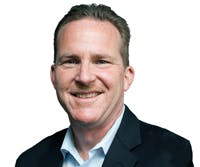Todd Martin
Senior Vice President, Business Development
Professional
I have been with Practice Fusion since May 2012. I have more than 20 years of experience with both startups and large public companies. My experience spans business development, sales, product management, support, software development, and professional services.
Education
I have a BS in Civil Engineering from the University of California, Davis.
Personal
Outside the office I can be found spending time with my wife and three sons, sharing their favorite endeavors, backpacking, camping, and an occasional do-it-yourself home improvement project.
If you were explaining Practice Fusion to someone who was not familiar with the company, how would you characterize its primary areas of expertise?
Practice Fusion is the largest physician-patient healthcare platform in the United States. We provide essential software and services for ambulatory physicians to run their practices and support the delivery of care to their patients. We also provide software and services for patients to manage their healthcare spending, access their personal health record, and schedule appointments with their doctor. Finally, we put these two offerings—our free, web-based electronic health record (EHR) platform, Practice Fusion, and our patient-facing platform, Patient Fusion—together so that doctors and patients have the type of connected, technology enabled, experience that we all have come to expect in 2014 but too rarely experience in healthcare.
What market or markets does Practice Fusion primarily serve? What are the major categories of solutions it offers to its customers?
Practice Fusion provides a 100% free, web-based EHR and personal health record (PHR) platform (for ambulatory providers, who make up 65% to 75% of the total population of physicians in the U.S. One in 4 physicians choosing an EHR today choose Practice Fusion. Our EHR includes e-Prescribing, medical charting, online booking, scheduling, referrals, billing integration, labs, imaging, and integration with our PHR.
Practice Fusion’s website refers to the “partner-supported” EHR model that the company offers its customers. Can you explain how this works and the benefits that it provides?
Medical professionals are increasingly choosing to work with companies that can provide essential healthcare services in a way that allows providers to meet systemic and regulatory requirements Those requirements include electronic ordering and the delivery of data directly to the provider in their EHR and in a way that they can satisfy their obligation to share the data with their patients.
Practice Fusion is the largest physician-patient platform in the U.S. There are more than 100,000 monthly active medical professionals using our platform and 4.5 million patient visits each month. Companies that partner with Practice Fusion can reach all their customers on our platform with one simple, easy to maintain, secure connection. Also, in addition to being the largest platform in the US, we are the fastest growing. Our partners are able to reach new customers instantly, with no incremental effort, as those customers are added to the Practice Fusion platform.
How do clinical labs fit into the emerging EHR paradigm? How does Practice Fusion address the needs of labs, in terms of revenue generation, integration with physician practices, or otherwise?
As EHR adoption continues to grow, the EHR is increasingly the physician’s “portal” into clinical lab services. In addition to consistent quality and excellent customer service, physicians are expecting laboratory services that fit into their need to satisfy core measures for Meaningful Use. For Meaningful Use Stage 2, physicians are required to order at least 30% of their lab tests and receive at least 55% of their lab test results electronically, directly in their EHR. By partnering with Practice Fusion, any clinical lab can present its customers and prospects with not only a free, web-based EHR but also one that includes lab ordering integrated into the native workflow of the EHR application. We configure our ordering application with the test compendium for each of our lab partners so the experience is consistent for physicians but also tailored to the specific business of each lab partner. Electronic ordering, coupled with the ability to deliver and present electronic results, satisfies all of a physician’s Meaningful Use needs. Practice Fusion has more than 300 lab partners to date with more than one million accessions being electronically delivered across our platform each month.
In addition to being a cost-effective solution for labs looking to satisfy their customers’ Meaningful Use requirements, the Practice Fusion platform can help reduce bad debt, improve test utilization, accelerate revenue, drive operational efficiency and increase revenue.
To help address bad debt, Practice Fusion provides the services to physicians so that each electronic order generated on the Practice Fusion platform includes verified insurance information and guarantor, and ensures that each order has been validated by the business rules of our partners.
Test utilization is improved through clinical decision support, corollary test recommendations, incorporation of laboratory testing guidelines, alerts on redundant orders, templates, and support for custom order sets. Ordering in the EHR enables a closed-loop system, allowing Practice Fusion to remind a patient to schedule an appointment with an intake center and intervene when a test result isn’t received for an order with the physician, the patient, or both.
Once a clinical lab is connected to Practice Fusion, setting up new customers is easy and fully automated, allowing new customers to start ordering from the lab in a matter of minutes. A physician on Practice Fusion can request an account or request his or her account to be connected to one of our clinical lab partners in a few clicks. Depending on the clinical labs’ approval process, the required connection from the lab to the physician can be set up in a matter of minutes.
Eliminating handwritten paper orders eradicates transcription errors by physician staff, improves the quality of the order being sent, and reduces the administration of order modifications.
Finally, given the size of the platform and the geographic reach, many labs have been able to attract new customers simply by being in the Practice Fusion lab directory, which facilitates regional targeting of lab services to Practice Fusion customers in the labs’ service area.
Can you give examples of the kinds of flexibility Practice Fusion offers?
Health technology is evolving rapidly, and constant change impacts the technology, the people, and the processes across the entire healthcare continuum. Partnering with an innovative and forward-looking technology company like Practice Fusion means that our partners stay ahead with us and can help define the latest innovations as we roll out and introduce innovation to our community. Our platform is designed with change in mind, whether those changes are driven by Meaningful Use, test guidelines, or fundamental shifts in the underlying technology used by everyone.
Many clinical labs have connections with in-practice desktop based EHR. Many of those connections are custom, point-to-point, and were developed based on HL7 v2.3.1. Meaningful Use 2014 requires those connections to be upgraded to HL7 v2.5.1. At Practice Fusion, we have already rolled out support for the new HL7 format and made it available to all of our clinical lab partners. Our platform allows each lab to update its connection once, and that consolidated connection is applicable for all of its customers on our platform the moment the change is made.
Meaningful Use certification is an important topic for clinical labs today and will become more important later this year and beyond. How does Practice Fusion help customers achieve certification?
As we head into 2014, Practice Fusion will be the largest community of 2014 Meaningful Use-certified practitioners in the country. Practice Fusion is also the largest platform for clinical laboratory connections available. We allow labs to make a single connection to all 100,000 monthly active users on our platform through our unique API, and in turn our providers can connect with labs to fulfill requirements at no cost. With the more demanding laboratory requirements of Stage 2 of Meaningful Use, our API provides the quickest and most efficient way for labs and practitioners to engage through EHR technology.
Providers on our platform are not only guaranteed 2014 certification, but also receive the best possible resources to make Meaningful Use easy, including in-product daily reports and free dedicated support—which is why Practice Fusion has been named the No. 1 EHR for Meaningful Use achievement two years in a row by Black Book Rankings.
What are some directions that the company may be taking in the near future in any or all of its core areas of expertise?
In addition to building out all the required features for Meaningful Use 2014, our product team has been busy delivering completely new EHR and PHR products for our customers based in HTML5. The technology change is important because in 2014 the EHR will be available and optimized for mobile, tablet, and computer screens. We have already started rolling out the new applications and expect the transformation to be complete in 2014.
We have launched an offering for imaging companies which is very similar to our offering for clinical laboratories. Interest is high and the number of imaging partners connected to the platform is expected to increase dramatically quarter over quarter in 2014.
We are also very excited about our Population Management solution for groups such as Accountable Care Organizations to stratify and manage entire populations of patients, providing real-time clinical insights and facilitating patient and provider interventions at the point of care to improve quality, outcomes and reduce cost.
Finally, we will be adding ways for partners to connect to our platform in 2014 beyond the API we have exposed to clinical labs, imaging partners, and billing software companies.






